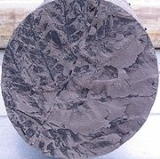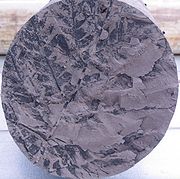
Surat Basin
Encyclopedia
The Surat Basin is a part of the Great Artesian Basin
of Australia
. The Surat Basin extends across an area of 270,000 square kilometres and the southern third of the basin occupies a large part of northern New South Wales
, the remainder is in Queensland
. It comprises Jurassic
through to Cretaceous
aged sediment
s derived from Triassic
and Permian
arc rocks of the Hunter-Bowen orogeny
. Towns situated above the basin, once dominated by agriculture, are experiencing a boom as mines and infrastructure in the area are expanded.
and southern Queensland
. It was formed by fluvial
sedimentation of an intracratonic area which underwent sediment sag-loading in the Jurassic to Cretaceous.
overlies the Palaeozoic igneous, metamorphic and sedimentary rocks of the Lachlan Fold Belt
.
In the east and northern parts of Queensland it unconformably overlies the sedimentary basin rocks of the Hunter-Bowen Orogen. The Surat Basin overlies parts of the Bowen Basin
in southern Queensland, and overlies the Gunnedah Basin in central New South Wales.
Palaeozoic basement highs mark the western and eastern boundaries of the Surat Basin. The Nebine Ridge delineates the boundary between the Surat Basin and the Eromanga Basin to the west. The Nebine Ridge is well developed in Queensland and gravity data indicate that the southern extension of the ridge into northern New South Wales is terminated by cross faulting. In Queensland the Kumbarilla Ridge divides the Surat Basin from the Clarence-Moreton Basin to the east.
The mostly flat-lying basin has a maximum thickness of about 2,500 m in Queensland, with up to 1,800 m preserved in New South Wales.
 More than 100 hydrocarbon accumulations have been found in the basin however only half are producing. The Surat Basin is not very important a target for oil
More than 100 hydrocarbon accumulations have been found in the basin however only half are producing. The Surat Basin is not very important a target for oil
as the source rock
s have not generally been subjected to suitable conditions to evolve oil. There is some slight natural gas potential. Jurassic coal
seams have been worked and explored in the Queensland portions of the basin.
- developing in the region. These fields presently supply the domestic market, including a number of power stations and the Roma to Brisbane Pipeline. A number of gas companies have recently announced plans to develop liquified natural gas plants in or around Gladstone
to export Surat Basin gas to international markets. The Port of Gladstone
is undergoing a A$
3.5 billion expansion to accommodate expected demands. In 2010, two energy companies confirmed their mines have the potential to affect groundwater levels.
Great Artesian Basin
The Great Artesian Basin provides the only reliable source of freshwater through much of inland Australia. The basin is the largest and deepest artesian basin in the world, stretching over a total of , with temperatures measured ranging from 30°C to 100°C...
of Australia
Australia
Australia , officially the Commonwealth of Australia, is a country in the Southern Hemisphere comprising the mainland of the Australian continent, the island of Tasmania, and numerous smaller islands in the Indian and Pacific Oceans. It is the world's sixth-largest country by total area...
. The Surat Basin extends across an area of 270,000 square kilometres and the southern third of the basin occupies a large part of northern New South Wales
New South Wales
New South Wales is a state of :Australia, located in the east of the country. It is bordered by Queensland, Victoria and South Australia to the north, south and west respectively. To the east, the state is bordered by the Tasman Sea, which forms part of the Pacific Ocean. New South Wales...
, the remainder is in Queensland
Queensland
Queensland is a state of Australia, occupying the north-eastern section of the mainland continent. It is bordered by the Northern Territory, South Australia and New South Wales to the west, south-west and south respectively. To the east, Queensland is bordered by the Coral Sea and Pacific Ocean...
. It comprises Jurassic
Jurassic
The Jurassic is a geologic period and system that extends from about Mya to Mya, that is, from the end of the Triassic to the beginning of the Cretaceous. The Jurassic constitutes the middle period of the Mesozoic era, also known as the age of reptiles. The start of the period is marked by...
through to Cretaceous
Cretaceous
The Cretaceous , derived from the Latin "creta" , usually abbreviated K for its German translation Kreide , is a geologic period and system from circa to million years ago. In the geologic timescale, the Cretaceous follows the Jurassic period and is followed by the Paleogene period of the...
aged sediment
Sediment
Sediment is naturally occurring material that is broken down by processes of weathering and erosion, and is subsequently transported by the action of fluids such as wind, water, or ice, and/or by the force of gravity acting on the particle itself....
s derived from Triassic
Triassic
The Triassic is a geologic period and system that extends from about 250 to 200 Mya . As the first period of the Mesozoic Era, the Triassic follows the Permian and is followed by the Jurassic. Both the start and end of the Triassic are marked by major extinction events...
and Permian
Permian
The PermianThe term "Permian" was introduced into geology in 1841 by Sir Sir R. I. Murchison, president of the Geological Society of London, who identified typical strata in extensive Russian explorations undertaken with Edouard de Verneuil; Murchison asserted in 1841 that he named his "Permian...
arc rocks of the Hunter-Bowen orogeny
Hunter-Bowen orogeny
The Hunter-Bowen Orogeny was a significant arc accretion event in the Permian and Triassic periods affecting approximately 2,500 km of the Australian continental margin....
. Towns situated above the basin, once dominated by agriculture, are experiencing a boom as mines and infrastructure in the area are expanded.
Formation
The Surat Basin is an intracratonic basin that covers a sizeable section of New South WalesNew South Wales
New South Wales is a state of :Australia, located in the east of the country. It is bordered by Queensland, Victoria and South Australia to the north, south and west respectively. To the east, the state is bordered by the Tasman Sea, which forms part of the Pacific Ocean. New South Wales...
and southern Queensland
Queensland
Queensland is a state of Australia, occupying the north-eastern section of the mainland continent. It is bordered by the Northern Territory, South Australia and New South Wales to the west, south-west and south respectively. To the east, Queensland is bordered by the Coral Sea and Pacific Ocean...
. It was formed by fluvial
Fluvial
Fluvial is used in geography and Earth science to refer to the processes associated with rivers and streams and the deposits and landforms created by them...
sedimentation of an intracratonic area which underwent sediment sag-loading in the Jurassic to Cretaceous.
Stratigraphy
The western central parts of the Surat basin unconformablyUnconformity
An unconformity is a buried erosion surface separating two rock masses or strata of different ages, indicating that sediment deposition was not continuous. In general, the older layer was exposed to erosion for an interval of time before deposition of the younger, but the term is used to describe...
overlies the Palaeozoic igneous, metamorphic and sedimentary rocks of the Lachlan Fold Belt
Lachlan Fold Belt
The Lachlan Fold Belt or Lachlan Orogen is a geological subdivision of the east part of Australia. It is a zone of folded and faulted rocks of similar age. It dominates New South Wales and Victoria, also extending into Tasmania, the Australian Capital Territory and Queensland. It was formed in...
.
In the east and northern parts of Queensland it unconformably overlies the sedimentary basin rocks of the Hunter-Bowen Orogen. The Surat Basin overlies parts of the Bowen Basin
Bowen Basin
The Bowen Basin contains the largest coal reserves in Australia. This major coal producing region contains one of the world's largest deposits of bituminous coal. The Basin contains much of the known Permian coal resources in Queensland including virtually all of the known mineable prime coking coal...
in southern Queensland, and overlies the Gunnedah Basin in central New South Wales.
Palaeozoic basement highs mark the western and eastern boundaries of the Surat Basin. The Nebine Ridge delineates the boundary between the Surat Basin and the Eromanga Basin to the west. The Nebine Ridge is well developed in Queensland and gravity data indicate that the southern extension of the ridge into northern New South Wales is terminated by cross faulting. In Queensland the Kumbarilla Ridge divides the Surat Basin from the Clarence-Moreton Basin to the east.
The mostly flat-lying basin has a maximum thickness of about 2,500 m in Queensland, with up to 1,800 m preserved in New South Wales.
Economic geology

Petroleum
Petroleum or crude oil is a naturally occurring, flammable liquid consisting of a complex mixture of hydrocarbons of various molecular weights and other liquid organic compounds, that are found in geologic formations beneath the Earth's surface. Petroleum is recovered mostly through oil drilling...
as the source rock
Source rock
In petroleum geology, source rock refers to rocks from which hydrocarbons have been generated or are capable of being generated. They form one of the necessary elements of a working petroleum system. They are organic-rich sediments that may have been deposited in a variety of environments including...
s have not generally been subjected to suitable conditions to evolve oil. There is some slight natural gas potential. Jurassic coal
Coal
Coal is a combustible black or brownish-black sedimentary rock usually occurring in rock strata in layers or veins called coal beds or coal seams. The harder forms, such as anthracite coal, can be regarded as metamorphic rock because of later exposure to elevated temperature and pressure...
seams have been worked and explored in the Queensland portions of the basin.
Mines
The basin has a number of mines such as Wilkie Creek Mine where Peabody Pacific mines and then exports coal.Coal seam methane
The basin has a number of coal seam methane fields - also known as coalbed methaneCoalbed methane
Coalbed methane or Coal Bed Methane, coalbed gas or coal mine methane is a form of natural gas extracted from coal beds. In recent decades it has become an important source of energy in United States, Canada, and other countries...
- developing in the region. These fields presently supply the domestic market, including a number of power stations and the Roma to Brisbane Pipeline. A number of gas companies have recently announced plans to develop liquified natural gas plants in or around Gladstone
Gladstone, Queensland
- Education :Gladstone has several primary schools, three high schools, and one university campus, Central Queensland University. It is also home to CQIT Gladstone Campus.- Recreation :...
to export Surat Basin gas to international markets. The Port of Gladstone
Port of Gladstone
The Port of Gladstone is Queensland's largest multi-commodity port and the fifth largest multi-commodity port in Australia. It is the world's fourth largest coal exporting terminal. It forms and integral part of the City of Gladstone in Central Queensland and is located about 525 km north of...
is undergoing a A$
Australian dollar
The Australian dollar is the currency of the Commonwealth of Australia, including Christmas Island, Cocos Islands, and Norfolk Island, as well as the independent Pacific Island states of Kiribati, Nauru and Tuvalu...
3.5 billion expansion to accommodate expected demands. In 2010, two energy companies confirmed their mines have the potential to affect groundwater levels.

